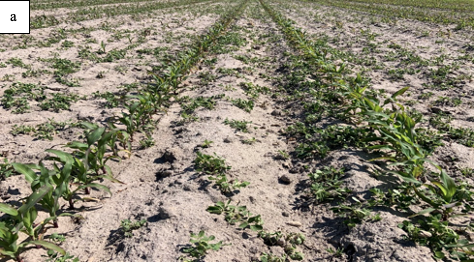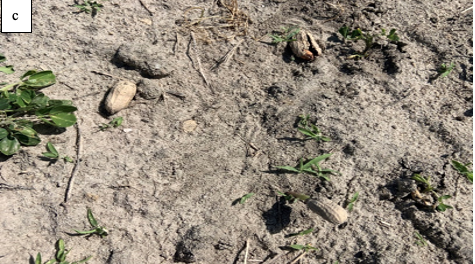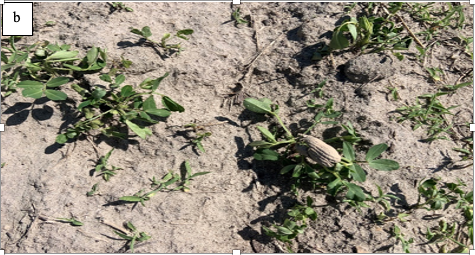Crops that emerge from seed left over from the previous season harvest are considered weeds in subsequent cropping cycles. In the case of peanuts, pods that detach from the pegs/vines during the digging and inversion process are not captured by the combine resulting in a harvest loss. The pods and seeds left at or below the soil surface after harvest can overwinter and germinate before or after the following crop is planted. With the newly planted rotation crop, these seedling peanuts can be competitive for nutrients, space, and water. This article discusses herbicide options for volunteer peanut control in corn and cotton.
Introduction
In 2019, peanuts were grown on approximately 65,000 acres in South Carolina.1 Harvest loss is defined as inability of the combine to capture the marketable product (e.g., peanut pods) from the mature crop on the ground. At maturity, peanuts are dug using a digger/inverter. The inverted vines are then left on the ground to dry for subsequent harvest using a specialized peanut combine. Peg strength declines significantly after peanut maturity is reached, which results in the pod detachment during the inversion process. Pods that detach from the peg/vine cannot be gathered and harvested by the peanut combine.2 In addition, improper depth settings on the peanut digger during the inverting process can result in shallow digging and pods being left in the soil profile.3 Soil texture (i.e., clay) can also cause the digging blade to rise up in the soil profile and miss the pods located near the bottom of the taproot.4 External factors, including weather events (fall tropical storms), can also delay harvest and contribute to pod loss. While many of these factors discussed previously can be controlled, harvest losses are expected because peanut is an indeterminate crop with a range of maturities in the pod profile.
Peanuts are typically rotated with a non-legume crop for a minimum of two years to mitigate disease pressure, such as Cylindrocladium black rot (Cylindrocladium parasiticum), early leaf spot (Passalora arachidicola), and late leaf spot (Nothopassalora personata).2 Corn or cotton is often planted the season following peanuts in South Carolina. Volunteer peanut plants that emerge during the 2-year rotation cycle can reduce the effectiveness of crop rotation for disease, insect, and nematode management (figure 1).5 Volunteer peanuts can also compete with the rotational crop for nutrients, water, space, and light. Preplant soil residual herbicides are typically used for management of weeds and volunteer crops, such as peanuts, during the period before planting. However, previous research on volunteer peanut control in corn and cotton has shown that soil residual herbicides, such as atrazine and fluometuron (Cotoran), provide limited suppression of volunteer peanut.6 The lack of control from these soil residual herbicides was often attributed to the large size of the peanut seed, and most soil-applied herbicides in cotton and corn are only effective on small-seeded weeds.


Figure 1. (a) Emerging and established volunteer peanuts in a cornfield about three weeks after planting, (b) a close-up view of emerging volunteer peanut plants, and (c) peanut pods left on the surface after harvest. Image credit: Michael W. Marshall, Clemson University.
Postemergence Herbicide Options for Managing Volunteer Peanuts
There are several postemergence preplant burndown options for controlling volunteer peanut before corn or cotton is planted. These include glyphosate (Roundup®), glufosinate (Liberty®), 2,4-D, and dicamba.7,8,9,10 Preplant applications of glyphosate, glufosinate, dicamba, and 2,4-D have limited soil activity on later emerging volunteer peanut plants. Previous research in cotton has shown glufosinate and glyphosate plus trifloxysulfuron (Envoke®) applied postemergence in crop (after cotton has reached the 5-leaf growth stage) provided between 87% to 100% volunteer peanut control.11 In corn, two sequential postemergence applications of dicamba and dicamba followed by linuron (Lorox®) controlled volunteer peanut 87% and 75%, respectively.11 Glufosinate is also registered for in-season postemergence use in both corn (LibertyLink® hybrids, BASF) and cotton (XtendFlex®, Bayer CropScience; Enlist™, Corteva AgriScience™).7 Similar to dicamba, one application of glufosinate provided 84% and 96% control of volunteer peanut at two different growth stages, respectively.12 Peanut control improved to 100%, regardless of growth stage at the time of application or the product use rate, when glufosinate was applied twice.12
Corn
Several trait technology platforms are available in corn hybrids that provide tolerance to glyphosate (Roundup Ready®, Bayer CropScience) or glufosinate [LibertyLink® (LL), BASF] herbicides. There are also stacked trait packages that offer a combination of one or more of those herbicides in a single hybrid. For example, Roundup Ready® and LibertyLink® stacks are common among seed providers along with an insect protection system, such as YieldGard® Corn Borer (YGCB, Bayer CropScience) or Herculex® 1 (HX1, Corteva AgriScience™.) Consult your local seed dealer for more details. Glufosinate (LL-corn hybrids, BASF) and dicamba herbicides are excellent control options for volunteer peanut in corn (table 1).
Table 1. Suggested herbicide combinations for volunteer peanut control in field corn. Consult the South Carolina Pest Management Handbook for the current herbicide product use guidelines, rates, and restrictions.
| Application Timing | Herbicide Program(s)a |
|---|---|
| Early Postemergence
(V2 to V6 growth stage) |
atrazineb + glyphosate (Roundup®) + dicamba (Clarity®)c or
atrazineb + glufosinate (Liberty®)d + dicamba or glufosinated + atrazineb or dicambac + atrazineb or dicamba + diflufenzopyr (Status®)e + atrazinea |
| Late Postemergencef
(V6 to V10 growth stage) |
glufosinated or
dicamba + diflufenzopyre |
a Each line under herbicide program(s) represents either a single herbicide product or a combination (tank mixture) of several herbicide products.
b Atrazine applications are not permitted after the V6 growth stage (~12 inches).
c Dicamba (Clarity®) applications are permitted from spike until the V5 growth stage; none are permitted after V5.
d LibertyLink® (BASF) corn hybrids only.
e Dicamba+diflufenzopyr postemergence applications are permitted from the V2 to V10 corn growth stages (use drop nozzles after the V7 growth stage). Status herbicide is a prepackaged herbicide product containing two active ingredients: dicamba and diflufenzopyr.
f Drop nozzles are recommended after the V7 corn growth stage to ensure adequate spray coverage of the volunteer peanuts at ground level.
Cotton
Cotton varieties are available in different stacked herbicide-tolerant platforms. These include glyphosate, glufosinate, and dicamba-tolerant (XtendFlex®, Bayer CropScience) and glyphosate, glufosinate, and 2,4-D tolerant (Enlist™, Corteva AgriScience™). Consult your local seed dealer for more details. Glufosinate and dicamba herbicides are excellent options for postemergence volunteer peanut in cotton (table 2).
Table 2. Suggested herbicide programs for volunteer peanut control in cotton. Consult the South Carolina Pest Management Handbook for the current herbicide product use guidelines, rates, and restrictions.
| Application Timing | Herbicide Program(s)a |
|---|---|
| Early Postemergence
(2-4 leaf growth stage) |
glufosinate (Liberty®) or
dicamba (Xtendimax®, Tavium®, or Engenia®)b,c or glufosinate + 2,4-D choline (Enlist One®)d or pyrithiobac (Staple®) or glyphosate (Roundup®) + dicambab,c or 2,4-D cholined or pyrithiobac |
| Late Postemergence (6-8 leaf growth stage) |
glufosinate or
dicambab,c or glufosinate + 2,4-D cholined or pyrithiobac or trifloxysulfuron (Evoke®)e or glyphosate + dicambab,c or 2,4-D cholined or pyrithiobac or trifloxysulfurone |
a Each line under herbicide program(s) represents either a single herbicide product or a combination (tank mixture) of several herbicide products.
b The current product labels of dicamba (Engenia®, Tavium®, and Engenia®) prohibit postemergence applications in Xtendflex® cotton after July 30 of each calendar year (Note: the cutoff date for the last Tavium® postemergence application is the 6-leaf growth stage or July 30, whichever comes first).
c XtendFlex® cotton varieties only. Exercise caution when spraying 2,4-D choline or dicamba near sensitive crops. Please note this includes applications of 2,4-D choline near XtendFlex® cotton varieties or dicamba applications near Enlist™ cotton varieties.
d Enlist cotton varieties only. Exercise caution when spraying 2,4-D or dicamba near sensitive crops. Please note this includes applications of 2,4-D choline near XtendFlex® cotton varieties or dicamba applications near Enlist cotton varieties.
e Apply trifloxysulfuron (Envoke®) after cotton has reached the 5-leaf growth stage. Use drop nozzles or directed applicator after cotton rows have reached canopy closure.
Key Points
- Glufosinate or dicamba herbicides are the most effective options for control of volunteer peanuts in corn and cotton.
- Tank mixing glufosinate and dicamba (Xtendimax®, Engenia®, or Tavium®) is prohibited because glufosinate increases volatility and off-site movement potential of the dicamba herbicide products.
- Target the herbicide application when volunteer peanuts are small and actively growing (i.e., plants not drought-stressed and/or too large and well-established)
- Glufosinate performance on volunteer peanuts is enhanced when the following environmental conditions are present at the time of application: warm temperatures, bright sunlight, and high humidity.8
- Consult and follow the guidelines for recommended adjuvants [i.e., Ammonium Sulfate (AMS) improves activity of glufosinate under dry conditions], use patterns, and other application parameters discussed in the herbicide product labels.
- During the “peanut-free” crop rotation period, management and elimination of volunteer peanuts are crucial for effective long-term management of diseases, insects, and nematodes.
References Cited
- Anonymous. Peanuts: U.S. acreage planted, harvested by state and region, 1980–2020. Washington (DC): United States Department of Agriculture, Economic Research Service. (accessed 2021 Apr 21). https://www.google.com/url?sa=t&rct=j&q=&esrc=s&source=web&cd=&ved=2ahUKEwiXlqKvhZDwAhVR-6wKHbsfA1IQFjAAegQIAxAD&url=https%3A%2F%2Fwww.ers.usda.gov%2Fwebdocs%2FDataFiles%2F52218%2FPeanuts.xlsx%3Fv%3D7035.5&usg=AOvVaw2rYPONflNTEnbZnAFJDVST
- Anco DJ, Thomas JS, Jordan DL, Shew BB, Monfort WS, Mehl HL, Small IM, Wright DL, Tillman BL, Dufault NS, Hagan AK, Campbell HL. Peanut yield loss in the presence of defoliation caused by late or early leaf spot. Plant Disease. 2020;1390–1399. https://doi.org/10.1094/PDIS-11-19-2286-RE.
- Warner AC, Kirk KR, Thomas JS, White JW, Peele JS, Massey HF, Fogle B. Peanut digging losses across soil moisture contents. 2015 ASABE Annual International Meeting Sponsored by ASABE; July 26–29, 2015; New Orleans (LA). St. Joseph (MI): American Society of Agricultural and Biological Engineers (ASABE); 2015 Paper No. 15219009. https://elibrary.asabe.org/pdfviewer.asp?param1=s:/8y9u8/q8qu/tq9q/5tv/L/3471IGHL/HLIHPGGGP.5tv¶m2=K/IH/IGIH¶m3=HJG.HIN.HNJ.KJ¶m4=46234.
- Warner AC, Kirk KR, Thomas JS, Monfort WS, White JW, Brantley SA, Peele JS, Han YJ, Massey HF. Variable depth peanut digger: part II–digging loss analysis. 2014 ASABE and CSBE/SCGAB Annual International Meeting; July 13–July 16, 2014; Montreal, Quebec Canada. St. Joseph (MI): American Society of Agricultural and Biological Engineers (ASABE); 2014. Paper No. 141914272. https://elibrary.asabe.org/pdfviewer.asp?param1=s:/8y9u8/q8qu/tq9q/5tv/L/243IGHK/HKHPHKINI.5tv¶m2=O/J/IGIH¶m3=HJG.HIN.HNJ.KJ¶m4=45062.
- Culbreath AK, Srinivasan R. Epidemiology of spotted wilt disease of peanut caused by tomato spotted wilt virus in the Southeastern U.S. Virus Research. 2011;159:101–109. https://doi.org/10.1016/j.virusres.2011.04.014.
- York AC, Jordan DL, Wilcut JW. Peanut control in rotation crops. Peanut Science. 1994;21:40–43. https://doi.org/10.3146/i0095-3679-21-1-10.
- Anonymous. Roundup PowerMAX herbicide product label. Bayer CropScience. 2020. p. 24. (accessed 2023 Feb 27). http://www.cdms.net/ldat/ld0RE000.pdf.
- Anonymous. Liberty herbicide product label. Bayer CropScience. 2017. p. 28. (accessed 2021 Apr 23) http://www.cdms.net/ldat/ldUA5010.pdf.
- Anonymous. 2,4-D amine herbicide product label. Agri Star. 2017. p. 28. (accessed 2021 Apr 23) http://www.cdms.net/ldat/ld4JF002.pdf.
- Anonymous. Clarity herbicide product label. BASF. 2010. p. 22. (accessed 2021 Apr 23). http://www.cdms.net/ldat/ld797012.pdf.
- Grichar WJ, Dotray PA. Control of peanut (Arachis hypogaea L.) with cotton (Gossypium hirsutum L.) herbicides. Peanut Science. 2007;34:109–113. https://doi.org/10.3146/0095-3679(2007)34[109:COPAHL]2.0.CO;2.
- Corbett JL, Askew SD, Thomas WE, Wilcut JW. Weed efficacy evaluations for bromoxynil, glufosinate, glyphosate, pyrithiobac, and sulfosate. Weed Technology. 2004;18:443–453. https://doi.org/10.1614/WT-03-139R.


